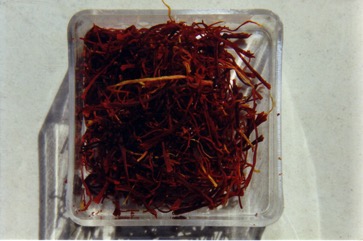Saffron, Saffron Crocus

A temperate plant. They require sun and good drainage. It needs a pH of 7. It is best in a good sandy loam. It is resistant to frost and drought. It suits hardiness zones 6-8. In Yunnan.
Also known as:
Fan-hung-hua, Gon-ga-man, Jafran, Kesar, Kesara, Kesari, Keshar, Keshara, Koma-koma, Kong, Kungumapu, Kunkumakesari, Kunkumapuvu, Pravi žafran, Saffraan, Za'faran, Zafferano, Zaffran, Zafran
Synonyms
- Crocus officinalis (L.) Honck.
- Crocus orsinii Parl.
- Crocus pendulus Stokes
- Crocus sativus var. cashmirianus Royle
- Crocus sativus var. officinalis L.
- Crocus sativus var. orsinii (Parl.) Maw.
- Crocus sativus subsp. orsinii (Parl.) K. Richt.
- Crocus setifolius Stokes
- Geanthus autumnalis Raf.
- Safran officinarum Medik.
Edible Portion
- Root, Corm, Herb, Spice, Pollen, Leaves, Flowers
Where does Saffron grow?
Found in: Africa, Algeria, Asia, Australia, Austria, Azerbaijan, Brazil, Britain, Canada, Caucasus, China, Egypt, Europe, France, Germany, Greece, Himalayas, India, Indonesia, Iraq, Iran, Israel, Italy, Japan, Malaysia, Mediterranean, Morocco, Myanmar, Nepal, New Zealand, North Africa, North America, Pakistan, Palestine, SE Asia, Slovenia, South America, Spain, Switzerland, Taiwan, Tasmania, Turkey, West Africa
Notes: There are about 80 Crocus species. It is a sterile triploid plant. It is mentioned in the Bible. Song of Songs 4:14. It has anticancer properties.
Growing Saffron, Saffron Crocus
Cultivation: It is grown from vegetative parts. Being a triploid plant it is sterile. Plant 3-15 cm deep and 10 cm apart. It won't flower in areas with wet cloudy summers.
Edible Uses: CAUTION: It is important to dry the flowers well before using for flavouring. Saffron is poisonous. A safe dose should not exceed 1 g per day. The stigmas or parts of the flower that catch pollen are used as a spice. They are used to colour and flavour sauces, creams, biscuits, preserves, liqueurs, curries, rice dishes, and other foods. The roots are eaten roasted. The leaves are used as a flavouring.
Production: The flowers are picked and the threadlike stamens removed. The flowers are then dried before using. Over 5,000 stigmas (1,700 flowers) are needed to give 25 g of dried saffron. (Or 200,000 flowers for a kg of saffron)
Nutrition Info
per 100g edible portion| Edible Part | Energy (kcal) | Protein (g) | Iron (mg) | Vitamin A (ug) | Vitamin c (mg) | Zinc (mg) | % Water |
|---|---|---|---|---|---|---|---|
| Flowers - dried | 311 | 11.4 | 11.1 | 53 | 80.8 | 1.1 | 11.9 |
Saffron, Saffron Crocus Photos

References
Ali-Shtayeh, M. S., et al, 2008, Traditional knowledge of wild edible plants used in Palestine (Northern West Bank): A comparative study. J Ethnobiol Ethnomed. 4: 13
Ambasta, S.P. (Ed.), 2000, The Useful Plants of India. CSIR India. p 146
Bianchini, F., Corbetta, F., and Pistoia, M., 1975, Fruits of the Earth. Cassell. p 214
Blamey, M and Grey-Wilson, C., 2005, Wild flowers of the Mediterranean. A & C Black London. p 498
Bodkin, F., 1991, Encyclopedia Botanica. Cornstalk publishing, p 300
Brickell, C. (Ed.), 1999, The Royal Horticultural Society A-Z Encyclopedia of Garden Plants. Convent Garden Books. p 318
Brown, D., 2002, The Royal Horticultural Society encyclopedia of Herbs and their uses. DK Books. p 183
Cundall, P., (ed.), 2004, Gardening Australia: flora: the gardener's bible. ABC Books. p 436
D'Agostino, N., et al, 2007, An EST database from saffron stigmas. BMC Plant Biology, 7:53
Ertug, F, Yenen Bitkiler. Resimli Türkiye Florası -I- Flora of Turkey - Ethnobotany supplement
Esperanca, M. J., 1988. Surviving in the wild. A glance at the wild plants and their uses. Vol. 2. p 188
Everest, A. & Ozturk, E., 2005, Focusing on the ethnobotanical uses of plants in Mersin and Adana provinces (Turkey). Journal of Ethnobiology and Ethnomedicine 1:6
Facciola, S., 1998, Cornucopia 2: a Source Book of Edible Plants. Kampong Publications, p 122
Flora of Pakistan. www.eFloras.org
Hedrick, U.P., 1919, (Ed.), Sturtevant's edible plants of the world. p 228
Hemphill, I, 2002, Spice Notes. Macmillan. p 337
Heywood, V.H., Brummitt, R.K., Culham, A., and Seberg, O., 2007, Flowering Plant Families of the World. Royal Botanical Gardens, Kew. p 3725
Hibbert, M., 2002, The Aussie Plant Finder 2002, Florilegium. p 76
Jacobsen, A. L., February 2013: edible Crocus www.arthurleej.com/plant of the month.html
Kintzios, S. E., 2006, Terrestrial Plant-Derived Anticancer Agents and Plant Species Used in Anticancer research. Critical Reviews in Plant Sciences. 25: pp 79-113
Kiple, K.F. & Ornelas, K.C., (eds), 2000, The Cambridge World History of Food. CUP p 434
Kybal, J., 1980, Herbs and Spices, A Hamlyn Colour Guide, Hamlyn Sydney p 86
Lim, T. K., 2015, Edible Medicinal and Non Medicinal Plants. Volume 9, Modified Stems, Roots, Bulbs. Springer p 28
Liu, Yi-tao, & Long, Chun-Lin, 2002, Studies on Edible Flowers Consumed by Ethnic Groups in Yunnan. Acta Botanica Yunnanica. 24(1):41-56
Marinelli, J. (Ed), 2004, Plant. DK. p 231
Morley, B. & Everard, B., 1970, Wild Flowers of the World. Ebury press. Plate 42
Mulherin, J., 1994, Spices and natural flavourings. Tiger Books, London. p 79
Plants for a Future database, The Field, Penpol, Lostwithiel, Cornwall, PL22 0NG, UK. http://www.scs.leeds.ac.uk/pfaf/
PROSEA handbook Volume 13 Spices. p 275
Seidemann J., 2005, World Spice Plants. Economic Usage, Botany, Taxonomy. Springer. p 122
Solomon, C., 2001, Encyclopedia of Asian Food. New Holland. p 317
Sp. pl. 1:36. 1753
Tyagi, R. K., et al, 2004, Conservation of Spices Germplasm in India. Indian J. Plant Genet. Resour. 17(3): 163-174
van Wyk, B., 2005, Food Plants of the World. An illustrated guide. Timber press. p 155
World Checklist of Useful Plant Species 2020. Royal Botanic Gardens, Kew